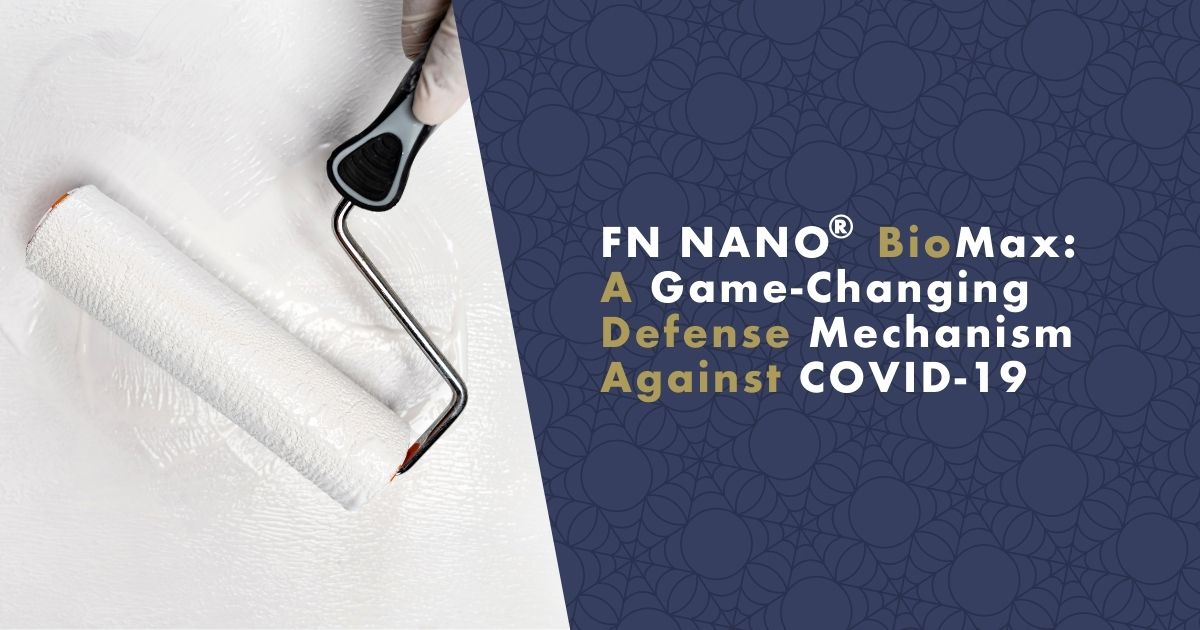Air purifiers, air ionization, continuous surface disinfection... these are some of the options to disinfect spaces where a larger number of people or sick individuals frequent. However, these solutions are relatively expensive and time-consuming.
Self-cleaning photocatalytic nano coating for walls, sometimes also referred to as intelligent or functional coating, manages many of the same tricks but at a lower cost and with longer-lasting effects.

European Patent in the Fight Against Covid-19
During the global pandemic of covid-19, many companies, restaurant owners, and operators of other facilities are seeking technologies to keep their premises clean and free of microorganisms, even when they have a high turnover of people. It is increasingly clear that increased hygiene standards will be necessary in the future because the new coronavirus is likely to stay with us for a long time. One of the technologies in the fight against Covid-19 is the European self-cleaning coatings FN NANO® BioMax.
Functional coatings are not a novelty in the market. FN NANO company has been producing interior and facade nano coatings for thirteen years and has even obtained a patent on the FN technology ("functional coatings"). The new functional coating FN NANO® BioMax has been specifically developed to eliminate microorganisms such as bacteria and viruses and has also received an assessment from the State Health Institute.

Tip: Discover the Magic of Photocatalytic Coatings: Cleaner Air and Pristine Walls Read the article and get familiar with photocatalytic coatings.
Photocatalysis = Cleaning with Light and Oxygen
So, how exactly does it work? You only need daylight and oxygen. These two basic ingredients are necessary for the functioning of the photocatalytic coating. FN NANO® BioMax is a protective coating based on titanium dioxide. The nanoparticles of titanium dioxide it contains are activated by daylight, and they literally burn harmful microorganisms. In a room where a sick person is present, there are aerosols or droplets containing viruses or bacteria. When such a droplet touches a lit surface coated with the functional coating, oxidation or burning occurs. However, do not imagine flames bursting from the wall. It's merely a chemical reaction breaking down into water and carbon dioxide molecules. The coating remains cool, of course.
It can also decompose other impurities commonly present in the air such as smoke, allergens, exhaust fumes, or mold spores. The result is much cleaner air in the room and consistent color on the walls. Another advantage of photocatalytic coatings is that all impurities that appear on them will self-clean. For instance, if you kill a fly on the wall, the stain will gradually disappear on its own. To be 100% effective, the coating must be directly exposed to daylight or, if necessary, the room can be illuminated with special lights that ensure the coating's effectiveness. As the process is powered by light, it is essentially inexhaustible, and no additional substances are released into the environment, as is the case with disinfectants.
Where Is the Functional Coating Suitable?
Its ideal use is in public buildings with a high turnover of people such as hospitals, banks, schools, conference rooms, but also in restaurants, cafes, or fitness centers. The use of photocatalytic coatings is also very appropriate in senior homes and other healthcare facilities. These coatings have their place in animal and food production, where they reduce odor and prevent the proliferation of unwanted microorganisms. However, the coating can also be used in outdoor spaces for treating facades, walls, or concrete structures. Its use as an anti-graffiti coating is also popular.
#produkty#https://www.nanospace.store/fn-nano-coatings/
Tip: Treating wood with a coating? Learn about selection and application in the guide.
Can I Apply the Coating Myself?
Yes, you can apply the intelligent coating yourself! The coating layer is applied to the surface using a brush, a low roller, or most easily, a sprayer. Three thin layers of the coating are optimal, and each layer must be allowed to dry thoroughly. However, before application, remember that you must shake the coating very thoroughly in the container and mix it thoroughly before application. This is necessary for even mixing of the insoluble powder component in the coating. You must shake it before each application; the coating and nanoparticles in it must be "constantly in motion."
Tip: Use a special foam roller for application, which won't drip, run, and will make working with nano coatings easier for everyone.
FN NANO® BioMax is semi-transparent, in its basic version, it has a white hue. The optimal thickness of the coating layer is 5-20 microns. The layer becomes active immediately upon exposure to daylight or artificial light with a UVA spectrum component. The coating matures after 24 hours. The typical consumption is one liter per 10 m2. You can purchase the FN® BioMax functional coating and other self-cleaning coatings from us.
Sources
- Anpo, M. (1989). Photocatalysis on small particle catalysis. Reaction intermediates and reaction mechanisms. Research on Chemical Intermediates.
- Inoue, T., Fujishima, A., Konishi, S., Honda, K. (1979). Photoelectrocatalytic reduction of carbon dioxide in aqueous suspensions of semiconductor powder. Nature, 277(5697), 637-638.
- Thampi, K.R., Viswanathan, B., Viswanath, R. (1987). Methanation and photo-methanation of carbon dioxide at room temperature and atmospheric pressure. Nature, 327(6119), 385-386.
- Taniguchi, I. (1979). Electrochemical and photoelectrochemical reduction of carbon dioxide. Helvetica Chimica Acta, 62(7), 2518-2531.
- Halmann, M., Krich, M., Mastai, Y. (1979). Hydrogen generation by visible light irradiation of aqueous solutions of metal complexes—An approach to the photochemical conversion and storage of solar energy. Helvetica Chimica Acta, 62(7), 2440-2447.

